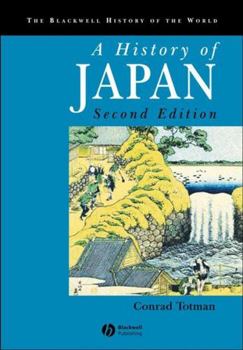Book Overview
This is an updated edition of Conrad Totman's authoritative history of Japan from c.8000 BC to the present day.
Format:Paperback
Language:English
ISBN:1405123591
ISBN13:9781405123594
Release Date:January 2005
Publisher:Wiley-Blackwell
Length:720 Pages
Weight:2.75 lbs.
Dimensions:1.5" x 6.6" x 9.6"
Customer Reviews
2 ratings
Comprehensive and accessible
Published by Thriftbooks.com User , 18 years ago
I had the good fortune to use (the first edition of) Conrad Totman's "History of Japan" in a series of introductory Japanese history courses for which I also read large parts of the two works with which it is often compared by other reviewers: George Sansom's three-volume history and the encyclopedic Cambridge history. This let me compare all three works and identify the strengths that each has relative to the others. Although I read the first edition, few major changes seem to have been made in the second edition, the main one being an expansion of the epilogue to discuss pressures associated with the war on terror and invasion of Iraq. As a one-volume work, Totman's history can't hope to include as much detail as the other two multi-volume histories. However, it nevertheless manages to present a comprehensive and very accessible history of Japan from prehistoric times to the twenty-first century. Unlike the Cambridge history, it is actually affordable, and unlike Sansom's work it includes events following the Meiji Restoration. Totman also spends considerably more time exploring Japanese society and economy than does Sansom, who focuses mainly on political, military and high-cultural affairs. Totman's main conceit is taking an 'ecological' approach to Japanese history that governs the book's structure even if it doesn't dominate the narrative as a whole. He divides Japanese history into four rough and somewhat overlapping periods, based on the dominant means of production: pre-agriculture, dispersed agriculture, intensive agriculture, and industrial. Each of these periods, he argues, exhibited an early high-growth phase when the spread of new techniques and technologies led to rapid increases in production and population, followed by longer periods of stasis. As a result of this approach, for instance, Totman considers the Meiji Restoration a less crucial transition than the process of industrialization that followed it later in the nineteenth century. Totman's interpretation is plausible, and I appreciated how he uses it to provide structure to his account, without forcing all aspects of Japanese history to fit into some overarching model. His writing was also quite accessible, and often a pleasure to read. The supplemental tables, glossary, index, annotated bibliography and limited notes were also helpful. Sansom and the Cambridge history may make more complete references, but of the three I found Totman's "History of Japan" the most interesting, accessible and enjoyable to read.
An outstanding history.
Published by Thriftbooks.com User , 24 years ago
Conrad Totman's A History Of Japan conceptualizes four major "ages" grounded in the material resources that sustained Japanese society: the age of foragers, dispersed agriculturalists, intensive agriculture, and industrialism. Totman beings with Stone Age society in Japan, and then moves through developments in agriculture, state-building, the blossoming of classical arts and letters, socioeconomic growth and change, domestic and diplomatic politics, social issues of class, gender and ethnicity, cultural production and the environmental effects of agricultural activity. A History Of Japan provides detailed coverage of the twentieth century when Japan grew into a much larger society and its role on the international science became militarily, economically, and culturally influential. A History Of Japan is a highly recommended, informative, scholarly, comprehensive, and "reader friendly" introduction and historical survey that will be much appreciated by students of Japanese history and culture, and has a wealth of material for the non-specialist general reader seeking to understand the Japan of antiquity as well as a contemporary and influential society.





